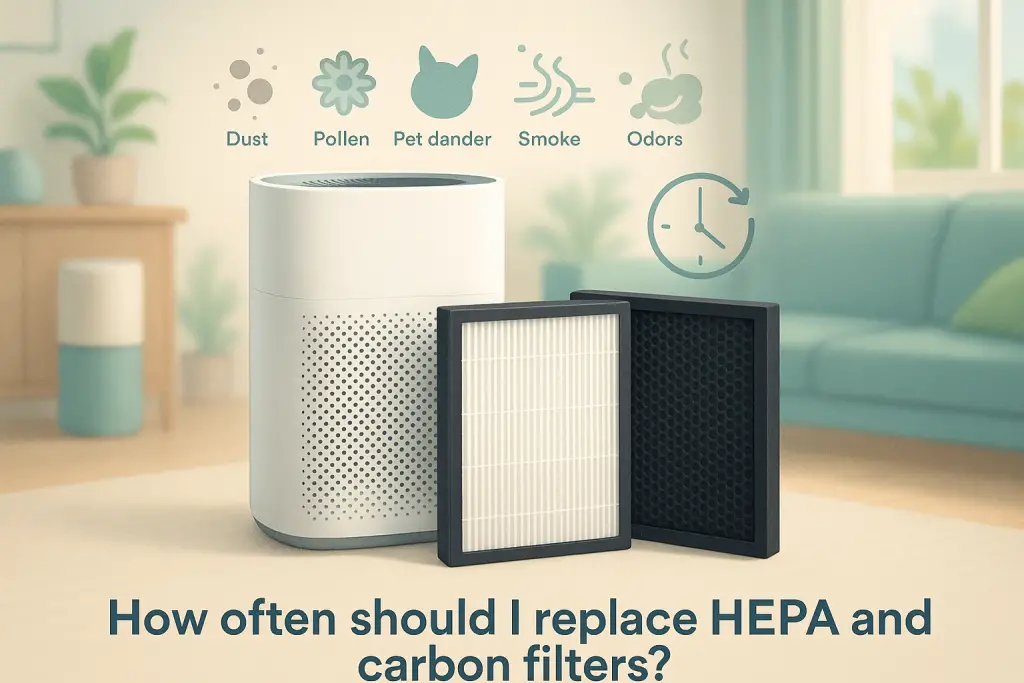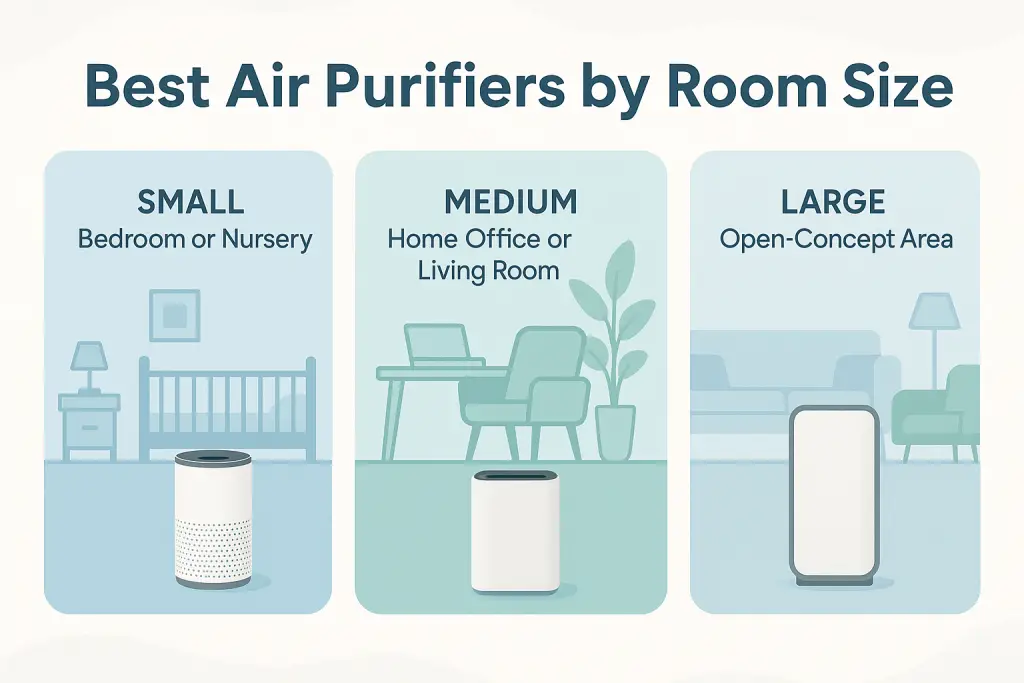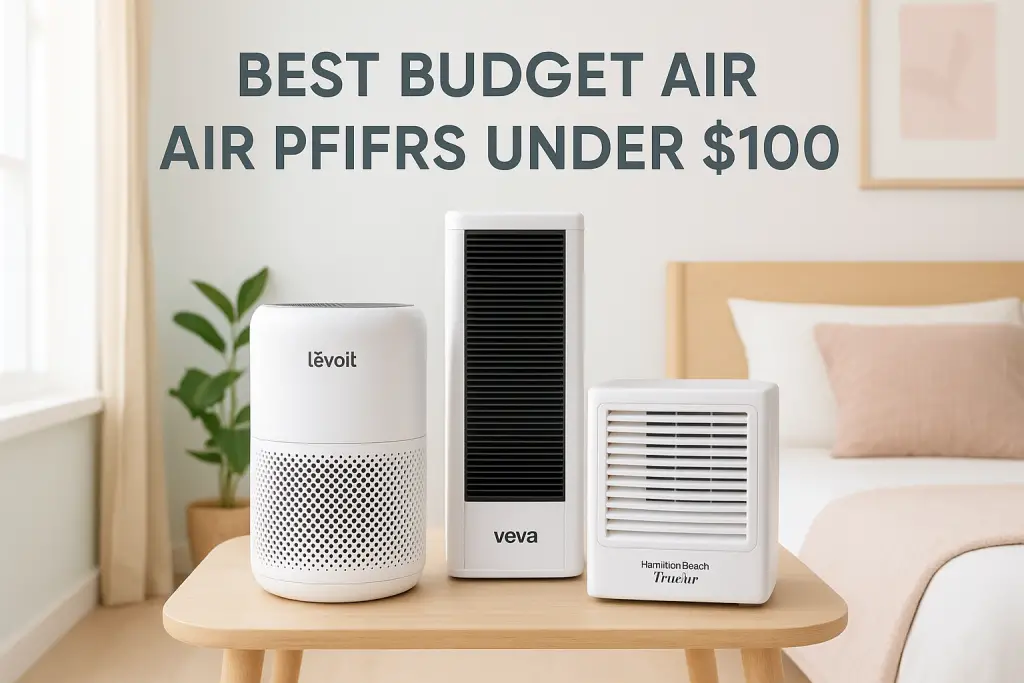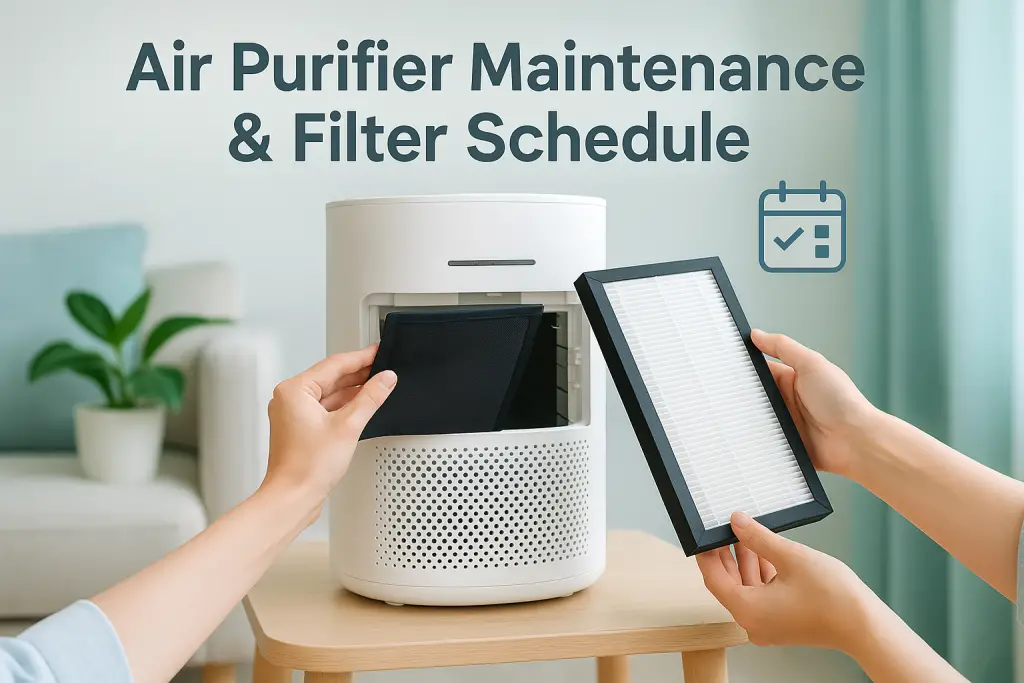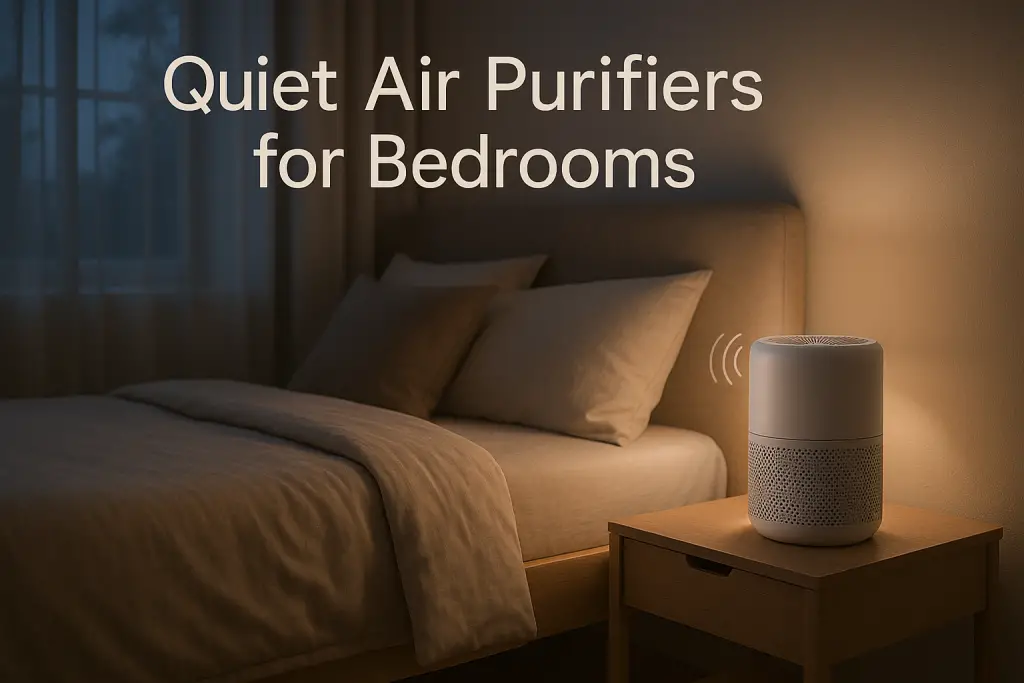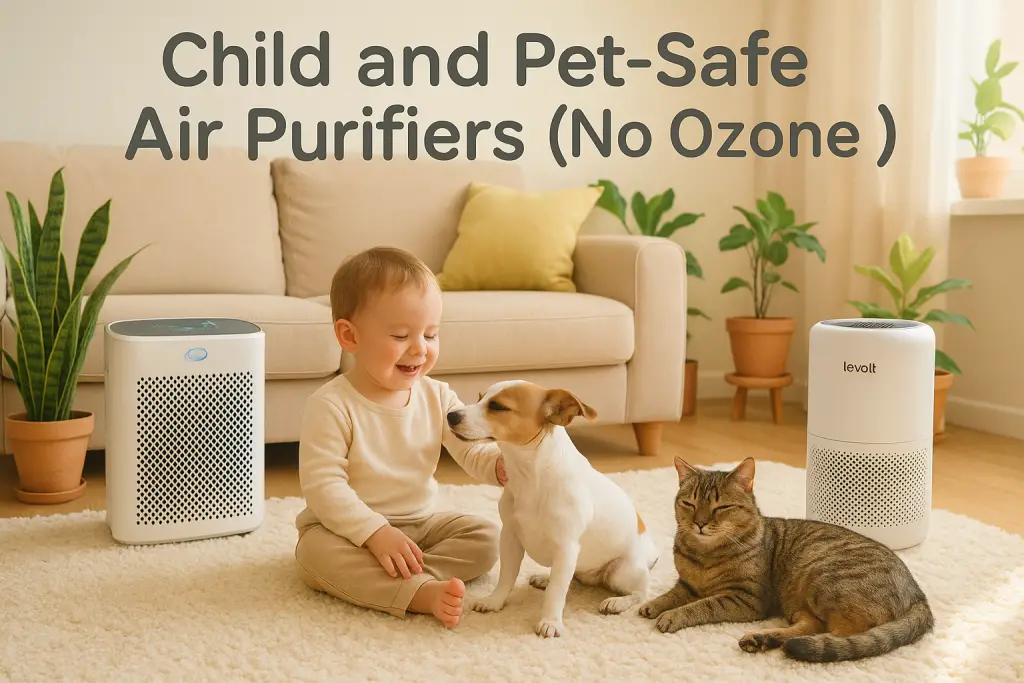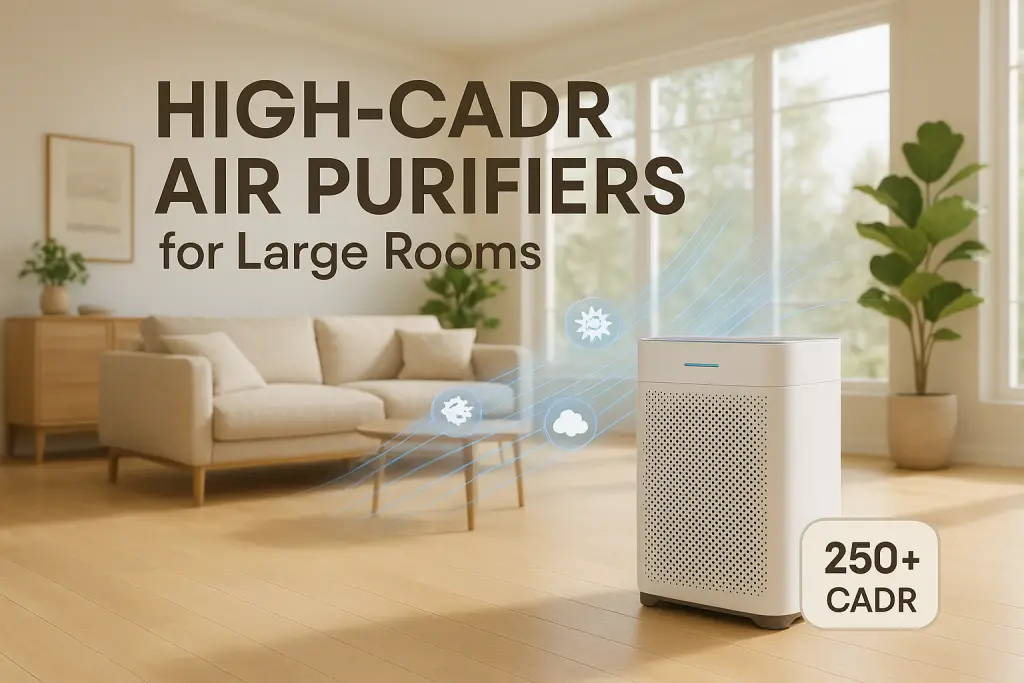Air purifiers play a vital role in maintaining clean indoor air by removing dust, pollen, pet dander, smoke, and odors. The heart of an air purifier’s effectiveness lies in its filter system, particularly HEPA and carbon filters. These filters need regular replacement to maintain optimal performance. This guide will explain exactly when to replace your filters, what factors affect their lifespan, and how to maximize their effectiveness while managing costs.
Understanding HEPA and Carbon Filters: How They Work and When They Expire
Before determining replacement schedules, it’s crucial to understand how HEPA and carbon filters work differently and why this affects their lifespan. Each filter type targets different pollutants and degrades in different ways.
HEPA Filters: Function and Failure Mechanisms
HEPA (High-Efficiency Particulate Air) filters capture 99.97% of particles as small as 0.3 microns through a complex mesh of fibers. These filters work through mechanical filtration, trapping particles as air passes through. HEPA filters primarily remove:
- Dust and dust mites
- Pollen and other allergens
- Pet dander
- Mold spores
- Bacteria and some viruses
Over time, particles accumulate within the filter fibers, gradually restricting airflow. When a HEPA filter becomes saturated, its efficiency drops dramatically, forcing the motor to work harder and allowing particles to escape back into your air.
When comparing different air cleaning technologies, HEPA filtration offers more reliable particle removal than ionizers, which can produce ozone and have variable effectiveness.
Carbon Filters: Adsorption Process and Saturation
Unlike HEPA filters, activated carbon filters work through adsorption to capture gases, odors, and VOCs. This process involves chemical pollutants binding to the carbon’s surface area within millions of tiny pores. Carbon filters target:
- Cooking odors
- Pet odors
- Smoke
- Volatile organic compounds (VOCs)
- Some chemicals and fumes
Once the carbon pores fill up, the filter can no longer capture additional gases or odors. Unlike HEPA filters, carbon saturation isn’t always visible to the naked eye. You might first notice returning odors before seeing any change in the filter’s appearance.
For households primarily concerned with eliminating odors, activated carbon filters are substantially more effective than HEPA filters, as HEPA technology isn’t designed to capture gaseous pollutants.
Manufacturer Recommendations vs. Reality: Standard Replacement Timelines
While manufacturers provide general guidelines for filter replacement, real-world conditions can significantly alter ideal replacement schedules. Let’s examine standard recommendations and how they translate to actual usage.
| Manufacturer | HEPA Filter Replacement | Carbon Filter Replacement | Pre-filter Replacement/Cleaning |
|---|---|---|---|
| Dyson | 12 months | 12 months (combined) | Monthly cleaning |
| Blueair | 6-12 months | 6 months | 2-4 weeks |
| Coway | 12 months | 6 months | 2 weeks |
| Levoit | 6-8 months | 6-8 months | 2-4 weeks |
| Honeywell | 12 months | 3-6 months | 3 months |
These recommendations represent ideal scenarios based on average household conditions and typical usage patterns. In reality, your specific environment and how you use your air purifier will significantly impact filter lifespan.
Decoding Manufacturer Guidelines: What They Don’t Tell You
Manufacturer guidelines typically assume “average” conditions, but several factors influence whether your filters need replacement sooner or can last longer than recommended.
- Definition of “average conditions”: Typically assumes moderate usage (8-12 hours daily), standard household dust levels, and no pets or smokers.
- Warranty considerations: Some warranties require following the manufacturer’s replacement schedule.
- Business model factors: Companies earn ongoing revenue from replacement filters, potentially leading to conservative replacement recommendations.
- Filter indicator limitations: Many built-in replacement indicators are simple timers rather than actual pollution sensors.
To maintain product quality and performance, you should be careful to avoid counterfeit replacement filters that might appear cheaper but often lack the filtration effectiveness and quality of genuine filters.
How often should I replace HEPA and carbon filters? Environmental Factors That Affect Filter Lifespan
Your home environment plays the most significant role in determining how quickly your filters will reach capacity. These key factors may require you to replace filters more frequently than standard recommendations.
High-Impact Environmental Factors
Certain environmental conditions dramatically accelerate filter saturation, potentially reducing filter lifespan by 50% or more from manufacturer recommendations.
- Pet ownership: One shedding dog or cat can reduce filter life by 30-50%. Multiple pets may require replacement every 2-3 months.
- Smoking or vaping indoors: Reduces filter life by 40-60%, with both HEPA and carbon filters saturating much faster.
- Frequent cooking: High-heat cooking, especially frying, creates both particles and odors, reducing filter life by 25-40%.
- Construction or renovation: Nearby construction can reduce filter life by up to 70% due to dust, debris, and VOCs.
- Wildfire smoke exposure: During wildfire season, filters may need replacement after just 2-4 weeks of heavy smoke.
Moderate and Seasonal Environmental Factors
Beyond major factors, these moderate and seasonal conditions can incrementally reduce filter lifespan or create temporary needs for more frequent replacement.
- Seasonal allergies: During high pollen seasons, HEPA filter lifespan may reduce by 15-25%.
- Humidity levels: High humidity (above 60%) can reduce carbon filter efficiency and promote mold growth on HEPA filters.
- Home size and placement: Using an undersized unit for your space accelerates filter saturation.
- Open windows: Frequent fresh air introduces more outdoor pollutants, reducing filter life by 10-20%.
- Seasonal activities: Holiday decorations, fireplace usage, and candles can temporarily increase filter load.
Usage Patterns and Settings: How You Use Your Air Purifier Matters
Beyond environmental factors, how you operate your air purifier significantly impacts filter lifespan. Understanding these relationships helps you balance air quality with filter longevity.
- Fan speed settings: Running constantly on high speed can reduce filter life by 30-40% compared to medium settings.
- Hours of operation: 24/7 operation will wear filters faster than 8-12 hours of daily use.
- Pre-filter maintenance: Regular pre-filter cleaning can extend main filter life by 20-30%.
- Auto-mode usage: Smart features that adjust speeds based on air quality can help optimize filter life.
Optimizing Settings for Filter Longevity
While clean air remains the priority, these strategic adjustments to how you operate your air purifier can help extend filter life without compromising air quality.
- Run on high speed for 1-2 hours when you first enter a room, then reduce to medium or low for maintenance.
- Place purifiers away from direct sources of pollutants to prevent rapid filter loading.
- Clean pre-filters weekly by vacuuming or washing (if washable) to prevent larger particles from reaching main filters.
- For multi-room homes, consider moving purifiers to high-need areas rather than running multiple units on low settings.
Planning ahead for your filter needs can save both money and hassle. Consider creating a yearly filter inventory plan based on your usage patterns and environmental factors.
Visual Indicators: How to Inspect Your Filters for Replacement
One of the most reliable ways to determine if your filters need replacement is through visual inspection. Learn to recognize these key indicators that signal it’s time for a new filter.
HEPA Filter Visual Assessment Guide
HEPA filters show clear visual signs when they’re reaching capacity. Follow this inspection process:
- Check color change: New HEPA filters are white or off-white. A filter that has turned gray, dark brown, or black is saturated with particles.
- Examine distribution: Even discoloration is normal. Spotty or uneven discoloration may indicate air bypassing parts of the filter.
- Look for buildup: Visible dust, hair, or buildup on the filter surface indicates saturation.
- Perform light test: Hold the filter up to light. If little to no light passes through, it’s time to replace.
- Check filter rigidity: If the filter material has become floppy or deformed, replace immediately.
Carbon Filter Assessment Challenges
Unlike HEPA filters, carbon filters rarely show obvious visual signs of saturation. Use these alternative assessment techniques:
- Odor test: If odors previously eliminated by your purifier begin returning, your carbon filter is likely saturated.
- Weight comparison: If possible, compare your used filter with a new one. Carbon filters become heavier as they absorb pollutants.
- Time-based tracking: In high-odor environments (cooking, pets, smoke), carbon filters typically last 3-6 months.
- Granule inspection: For visible carbon granules, check if they’ve changed from black to grayish.
When disposing of used filters, follow proper practices to prevent releasing trapped contaminants. Bagging and safely disposing of used filters helps contain allergens and pollutants that accumulated during their service life.
Performance Indicators: Signs Your Air Purifier Needs New Filters
Beyond visual inspection, your air purifier will demonstrate performance changes that signal filter saturation. Learn to recognize these warning signs that replacement is needed.
- Decreased airflow: Hold your hand in front of the output vent. Noticeably weaker airflow suggests clogged filters.
- Increased noise: The motor working harder to pull air through clogged filters often produces more noise.
- Return of odors: If smells previously eliminated by your purifier return, your carbon filter is likely saturated.
- Increased dust: More dust settling on surfaces despite running the purifier indicates filter inefficiency.
- Allergic symptoms: If allergy symptoms that had improved return, filters may need replacement.
Monitoring Air Quality Changes
The ultimate test of your air purifier’s filter condition is its effectiveness in maintaining air quality. Here’s how to monitor performance changes that indicate replacement is needed:
- Use an independent air quality monitor to track particulate matter (PM2.5) levels.
- Compare your purifier’s response time after introducing pollutants (cooking, etc.) to when it was new.
- Monitor changes in indoor air quality when outdoor pollution spikes.
- Track allergy symptoms of household members as potential indicators.
Special Circumstances: When Standard Rules Don’t Apply
Certain situations require special consideration when determining filter replacement timing. These scenarios may necessitate customized replacement schedules.
- Homes with immunocompromised residents: Replace filters 30-50% more frequently than manufacturer recommendations.
- Severe allergy and asthma sufferers: Replace HEPA filters every 3-4 months, regardless of appearance.
- New parents and infants: For nurseries, maintain a more frequent replacement schedule for the first year.
- Post-construction or renovation: Replace filters 2-4 weeks after project completion, then resume normal schedule.
- After disasters: Replace filters immediately after wildfire smoke events or flooding.
Health-Sensitive Populations: Erring on the Side of Caution
For households with health-vulnerable members, filter replacement timing should prioritize maximum air quality over cost considerations. Here’s how to adjust your approach:
- For asthma sufferers, replace filters at the first sign of decreased effectiveness.
- In elderly care environments, maintain strict replacement schedules regardless of visual indicators.
- For immunocompromised individuals, consider hospital-grade filtration with more frequent changes.
- With respiratory conditions, monitor symptoms closely as early indicators of filter saturation.
- Consult healthcare providers about air quality monitoring and optimal purification for specific conditions.
Cost-Effective Replacement Strategies: Maximizing Filter Life and Value
While timely filter replacement is essential, several strategies can help optimize costs without compromising air quality. Implement these approaches to maximize value and performance.
Consider how your air purification choices impact the environment. Understanding the carbon footprint of air purifiers versus natural ventilation methods can help you make more sustainable choices while still maintaining good air quality.
- Pre-filter maintenance: Weekly cleaning of washable pre-filters can extend main filter life by 20-30%.
- Strategic operation: Run at high speeds only when needed, using lower settings for maintenance.
- Filter subscription services: Many brands offer 10-20% discounts on automatic filter deliveries.
- Third-party filters: Quality compatible filters can save 30-50% over OEM versions.
- Bulk purchasing: Buying yearly supplies can reduce costs by 15-25%.
Filter Replacement Cost Comparison
Filter costs vary dramatically across brands and types. This comparative analysis helps you understand replacement economics and potential savings opportunities.
| Brand | OEM Filter Cost | Replacement Frequency | Yearly Cost | Third-Party Options |
|---|---|---|---|---|
| Dyson | $70-80 | 12 months | $70-80 | Limited |
| Blueair | $60-120 | 6 months | $120-240 | Yes, 30-40% savings |
| Coway | $50-70 | 12 months (HEPA), 6 months (Carbon) | $100-140 | Yes, 20-30% savings |
| Levoit | $30-50 | 6-8 months | $45-100 | Yes, 40-50% savings |
| Honeywell | $25-60 | 12 months (HEPA), 3 months (Carbon) | $100-240 | Yes, 30-45% savings |
Beyond your home, don’t forget that air quality in your vehicle also matters. Cabin filters in cars need regular replacement to maintain good air quality during your commute and travel.
Frequently Asked Questions About Filter Replacement
These commonly asked questions address specific scenarios and concerns about HEPA and carbon filter replacement timing and practices.
Can I vacuum or wash HEPA filters instead of replacing them?
Most HEPA filters cannot be washed or vacuumed without damaging the delicate fiber structure. A few specific models are marketed as “washable HEPA,” but these typically achieve lower filtration efficiency after washing. Standard HEPA filters should be replaced, not cleaned.
Do I need to replace both HEPA and carbon filters at the same time?
Not necessarily. Carbon filters typically saturate faster than HEPA filters, especially in odor-heavy environments. Replace each filter type based on its own condition and performance.
Are third-party replacement filters as effective as originals?
Quality varies significantly. Look for third-party filters with HEPA certification and good reviews. While some perform comparably to OEM filters at lower costs, others may have lower efficiency or shorter lifespans.
Can I extend filter life by running my purifier less often?
Yes, but this may compromise air quality. Instead, consider running on lower speed settings during clean air periods and higher speeds only when needed.
How do smart features and replacement indicators work?
Most indicator lights are simple timers based on hours of operation. Advanced models with actual particle sensors provide more accurate replacement timing based on actual filter load.
Conclusion: Creating Your Personalized Filter Replacement Schedule
Based on the comprehensive factors we’ve covered, it’s time to create a personalized filter replacement schedule that balances optimal air quality with cost-effectiveness.
Start by determining your baseline using manufacturer recommendations, then adjust based on:
- Your specific environmental factors (pets, cooking habits, allergies)
- Usage patterns and settings you typically employ
- Special health considerations for household members
- Seasonal variations that affect air quality
Document filter changes and observations about performance to fine-tune your schedule over time. While manufacturers provide useful guidelines, your actual replacement needs are unique to your situation.
Remember that proper filter replacement is an investment in health, not just an expense. Clean air contributes to better sleep, reduced allergy symptoms, and overall improved quality of life.
| Photo | Air Purifier Model | Best for | Price |
|---|---|---|---|

|
WINIX A231 Air Purifier | Asthma & Indoor Pollution | Check Price On Amazon |

|
Rabbit Air, A3 SPA-1000N Air Purifier | Pet Dander & Odors | Check Price On Amazon |

|
LEVOIT Air Purifier | Best Overall | Check Price On Amazon |

|
GermGuardian Air Purifier | Cigarette & Cooking Smoke | Check Price On Amazon |

|
Coway Airmega Air Purifier | New-borns | Check Price On Amazon |

|
BLUEAIR Air Purifier | Germ & Virus Control | Check Price On Amazon |
